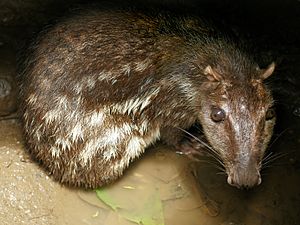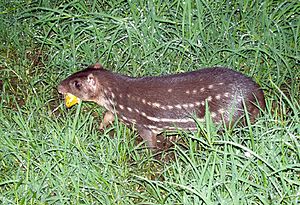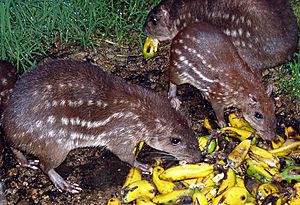Paca facts for kids
Quick facts for kids Pacas |
|
|---|---|
 |
|
| Lowland Paca | |
| Scientific classification | |
| Kingdom: | |
| Phylum: | |
| Class: | |
| Order: | |
| Suborder: |
Hystricomorpha
|
| Genus: |
Cuniculus
|
| Species | |
| Synonyms | |
|
For Cuniculidae:
For Cuniculus:
|
|
A paca is a large rodent that lives on the ground. You can find them in South and Central America. They are plant-eaters, meaning they only eat plants.
Pacas belong to the genus Cuniculus. They are the only animals in their family, called Cuniculidae. These rodents have spots and stripes on their sides. They also have short ears and tails that are hard to see. Sometimes, people call them "gibnuts" or "royal rats."
The Smithsonian Tropical Research Institute in Panama has studied pacas. They are looking into whether pacas could be a good food source in tropical areas.
Contents
Where Pacas Come From
Pacas first appeared in South America. They are one of the few mammal species that moved to North America. This happened after a big event called the Great American Interchange, about 3 million years ago.
Pacas used to be grouped with agoutis in the Dasyproctidae family. But now, pacas have their own family. This is because they have different numbers of toes. Their skulls are also shaped differently, and their fur patterns are unique.
What Pacas Look Like
Pacas are about 50 to 77 centimeters (20 to 30 inches) long. This measurement does not include their short tail, which is about 13 to 23 centimeters (5 to 9 inches). They weigh between 6 and 14 kilograms (13 to 31 pounds). This makes them the sixth-largest rodents in the world.
They look a bit like large guinea pigs. Pacas have square heads and small ears. Their sides are covered with spots and stripes. Their tails are so small they are almost invisible.
Pacas have strong hind legs and smaller front legs. Their bodies are shaped like a cone. They look a bit like small deer called chevrotains. Like chevrotains, pacas have four to seven lines of spots and stripes along their sides.
They look heavy and strong, but their legs are long and quite thin. Their small ears are placed high on their heads. Pacas have four toes on their front feet and five on their back feet. Two of their back toes are very short and barely touch the ground. Their nails are strong and look like tiny hooves.
Young pacas have skin covered with small, hard scales. These scales are about 2 millimeters (0.08 inches) wide. They might help protect the young pacas from small predators. Male and female pacas look almost the same. Pacas can live up to 13 years in the wild.
Paca Behavior
Pacas live in rainforests and cloud forests. Sometimes, they can be found in more open areas. They are excellent swimmers and like to stay close to water. If they feel threatened, they will dive into the water. They can stay underwater for up to 15 minutes!
Pacas can also jump up to 1 meter (3 feet) high. They can freeze in place for up to 45 minutes to avoid being seen. They usually travel along paths they have already made. If an old path is disturbed, they will create new ones.
During the day, pacas are usually calm. They look for food in the morning and afternoon. However, in places with many predators, they might only come out at night. They live in burrows that can be up to 3 meters (10 feet) deep. These burrows usually have two entrances. Pacas cover the entrances with leaves to hide them. This also helps them know if something is trying to get in.
Their burrows are often near water, but always above where floods might reach. Besides humans, their predators include jaguars, pumas, ocelots, margays, jaguarundis, bush dogs, boa constrictors, and caimans.
Pacas have special chambers in their cheeks that help make sounds. Their growling noise is surprisingly loud for their size, about 1 kilohertz. Besides making noises, pacas mark their territory with urine. Many pacas can live in one area. Sometimes, pacas make up about 20% of all the land mammals in a place.
What Pacas Eat
In the wild, pacas eat fruits from small trees and fallen fruits from taller trees. They might also eat leaves, buds, flowers, fungi, and insects. They are very important for spreading seeds. Their home areas often have groups of fruit trees.
Pacas usually do not use their front paws to hold fruits, unlike agoutis. Instead, they use their strong jaw muscles to break open hard-shelled fruits. Unlike agoutis, pacas can store fat in their bodies. This means they don't need to hide seeds for later.
Pacas avoid competing with agoutis by having slightly different daily routines and food choices. Like rabbits, pacas eat their own special moist droppings. This helps them get more protein and carbohydrates from their food. Before their babies drink milk, mothers lick them. This makes the babies go to the bathroom. The mother then licks up the waste. This helps her get nutrients and also keeps the area clean so predators are not attracted by the smell.
Paca Reproduction and Life Cycle
A paca's pregnancy lasts between 114 and 119 days. A mother can give birth up to three times a year if conditions are good. If she has more than one birth a year, she might be nursing one baby while pregnant with another.
Paca babies are born ready to go. They have fur and their eyes are open. Usually, a mother gives birth to one baby at a time. Babies start to stop drinking milk after six weeks. However, they begin following their mothers early on. They can stay with their mothers for up to a year.
Pacas have a different way of protecting their young compared to many rodents. Instead of having many babies for safety, they carefully look after their few offspring. Babies weigh about 650 to 710 grams (1.4 to 1.6 pounds) at birth. They are born in holes that are too small for predators or even the mother to enter. The mother then covers these holes with leaves and twigs.
To get the baby out of the hole, the mother makes a soft, rolling sound. Babies usually drink milk for 90 days. By then, they weigh about 4 kilograms (8.8 pounds).
Where Pacas Live
The lowland paca can be found from southern Mexico all the way to northern Argentina. They mostly live in rainforests near streams. But they can also live in many other places. These include mangrove swamps, forests along rivers, and even public parks. They have been seen as high as 2,500 meters (8,200 feet) above sea level.
The smaller mountain paca lives in the northern Andes mountains. They also live in the Páramo grasslands. They are most often found between 2,000 and 3,000 meters (6,500 and 9,800 feet) above sea level.
Types of Pacas
The mountain paca has longer and darker fur than the lowland paca. Mountain pacas are usually found between 1,500 and 2,800 meters (4,900 and 9,200 feet) above sea level.
- Lowland paca, Cuniculus paca
- Mountain paca, Cuniculus taczanowskii
- Cuniculus hernandezi (a newly named species that is still being debated)
See also
 In Spanish: Pacas para niños
In Spanish: Pacas para niños



